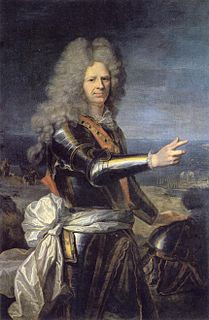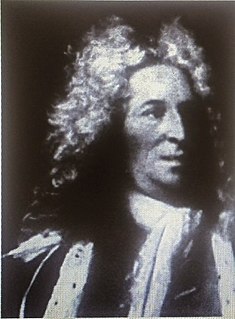Related Research Articles

Buccaneers were a kind of privateers or free sailors particular to the Caribbean Sea during the 17th and 18th centuries. First established on northern Hispaniola as early as 1625, their heyday was from the Restoration in 1660 until about 1688, during a time when governments were not strong enough and did not consistently attempt to suppress them.

Jean-Baptiste du Casse was a French privateer, admiral, and colonial administrator who served throughout the Atlantic World during the 17th and 18th centuries. Likely born 2 August 1646 in Saubusse, near Pau (Béarn), to a Huguenot family, du Casse joined the French merchant marine and served in the East India Company and the slave-trading Compagnie du Sénégal. Later, he joined the French Navy and took part in several victorious expeditions during the War of the League of Augsburg in the West Indies and Spanish South America. During the War of the Spanish Succession, he participated in several key naval battles, including the Battle of Málaga and the siege of Barcelona. For his service, he was made a knight of the Order of the Golden Fleece by King Philip V of Spain. In the midst of these wars, he was Governor of the colony of Saint-Domingue from 1691 to 1703. He ended his military career at the rank of Lieutenant General of the naval forces and Commander of the Royal and Military Order of Saint Louis. He died on 25 June 1715 in Bourbon-l'Archambault, Auvergne.

Edward Davis or Davies was an English buccaneer active in the Caribbean during the 1680s and would lead successful raids against Leon and Panama in 1685, the latter considered one of the last major buccaneer raids against a Spanish stronghold. Much of his career was later recorded by writer William Dampier in A New Voyage Round the World (1697).
Anne "Dieu-Le-Veut" de Graaf also called Marie-Anne or Marianne was a French pirate. Alongside Jacquotte Delahaye, she was one of very few female buccaneers. While Delahaye was likely fictional, Dieu-le-Veut was real; however, many of her exploits are inventions of later writers.
See also 1719 in piracy, 1721 in piracy and Timeline of piracy.
William Mayes was a pirate active in the Indian Ocean. He was best known for taking over William Kidd’s ship Blessed William and sailing with Henry Avery.
Josiah Raynor (1665–1743) was a pirate active in the Red Sea. Before he was briefly a pirate captain, he was a sailor on the Batchelor’s Delight on which he sailed alongside William Dampier.
John Philip Bear, last name also spelled Beare, was a 17th-century English pirate active in the Caribbean who also served with the Spanish and French.
Jean Fantin was a French pirate active in the Caribbean and off the coast of Africa. He is best known for having his ship stolen by William Kidd and Robert Culliford.
Jean Charpin was a French pirate and buccaneer active in the Caribbean and off the coast of Africa. He is best known for sailing alongside Jean-Baptiste du Casse as well as for his Articles, or “Pirate Code.”
Francois Groginet was a French buccaneer and pirate active against the Pacific coast of Spanish Central America.
Jean L’Escuyer was a French pirate active on the Pacific coast of Central America. He sailed and fought alongside a number of prominent buccaneers such as Edward Davis, Francois Grogniet, William Dampier, and others.

Étienne de Montauban was a French flibustier (buccaneer), privateer, and pirate active in the Caribbean and off the west African coast. Frequently referred to as Sieur de Montauban, he wrote an account of his later voyages including surviving a shipwreck.
Charles de Courbon, comte de Blénac was a French colonial administration who served as governor general of the French Antilles during the 17th century. He was an experienced soldier and fought for the king during the Fronde before becoming a naval officer in the French Navy. Towards the end of the Franco-Dutch War he led the land forces that captured Tobago from the Dutch before taking command of the French Antilles. During the Nine Years' War he was active in the struggle with the English and Dutch in the Windward Islands. He captured Sint Eustatius and Saint Kitts, and defended Martinique against a large English expedition in 1693.
François d'Alesso, Marquis d'Éragny was a French soldier who was briefly governor general of the French Antilles.
Charles de Pechpeyrou-Comminges, chevalier de Guitaut was a French army and naval officer who became governor of Martinique and then of Saint Christophe. He was three times acting lieutenant-general of the French Antilles.

Thomas Claude Bernard Renart de Fuschamberg, marquis d'Amblimont was a French naval officer who was governor general of the French Antilles. He is best known for his 1674 defense of Martinique against Dutch forces under Admiral Michiel de Ruyter, where he was captain of a warship that played a critical role in driving the Dutch land forces off their beachhead.
Claude de Roux, chevalier de Saint-Laurent was a French soldier, a chevalier of the Knights Hospitaller, who was governor of the colony of Saint Christophe on Saint Christopher Island from 1666 to 1689. He took office in the Second Anglo-Dutch War (1665–67), when the French expelled the English from the island, and left office early in the Nine Years' War (1688–97), when the English expelled the French from the island.
Charles Auger de La Motte was a French colonial administrator. He was governor in turn of Marie-Galante, Guadeloupe and Saint-Domingue.
References
- ↑ Gerhard, Peter (2012). Pirates of New Spain, 1575-1742. New York: Courier Corporation. ISBN 9780486149141 . Retrieved 8 September 2017.
- ↑ Lane, Kris (1998). Pillaging the Empire: Piracy in The. New York: M.E. Sharpe. ISBN 9780765630834 . Retrieved 8 September 2017.
- ↑ Zacks, Richard (2003). The Pirate Hunter: The True Story of Captain Kidd. New York: Hachette Books. ISBN 9781401398187 . Retrieved 31 August 2017.
- 1 2 3 4 5 6 Gasser, Jacques (1992–1993). "De la mer des Antilles à l'océan Indien (From the Caribbean Sea to the Indian Ocean)". Bulletin du Cercle généalogique de Bourbon (Bulletin of the Bourbon Genealogical Circle). 38–41. Retrieved 31 August 2017. French language original, as reprinted in Le Diable Volant : Une histoire de la flibuste : de la mer des Antilles à l'océan Indien (1688-1700) / ('The Flying Devil : A History of the Filibusters : From the Antilles to the Indian Ocean (1688-1700)').
- ↑ Harrison, Simon. "Etienne de Montauban (1660-?)". threedecks.org. Retrieved 8 September 2017.
- ↑ Grey, Charles (1933). Pirates of the eastern seas (1618-1723): a lurid page of history. London: S. Low, Marston & co., ltd. p. 156. Retrieved 26 June 2017.
- ↑ Gourong, Enguerrand. "Histoire de l'ile de Groix et de la famille Gourong". enguerrand.gourong.free.fr. Retrieved 8 September 2017.
- ↑ Jameson, John Franklin (1923). Privateering and Piracy in the Colonial Period by J. Franklin Jameson. New York: Macmillan. p. 193. Retrieved 26 June 2017.
